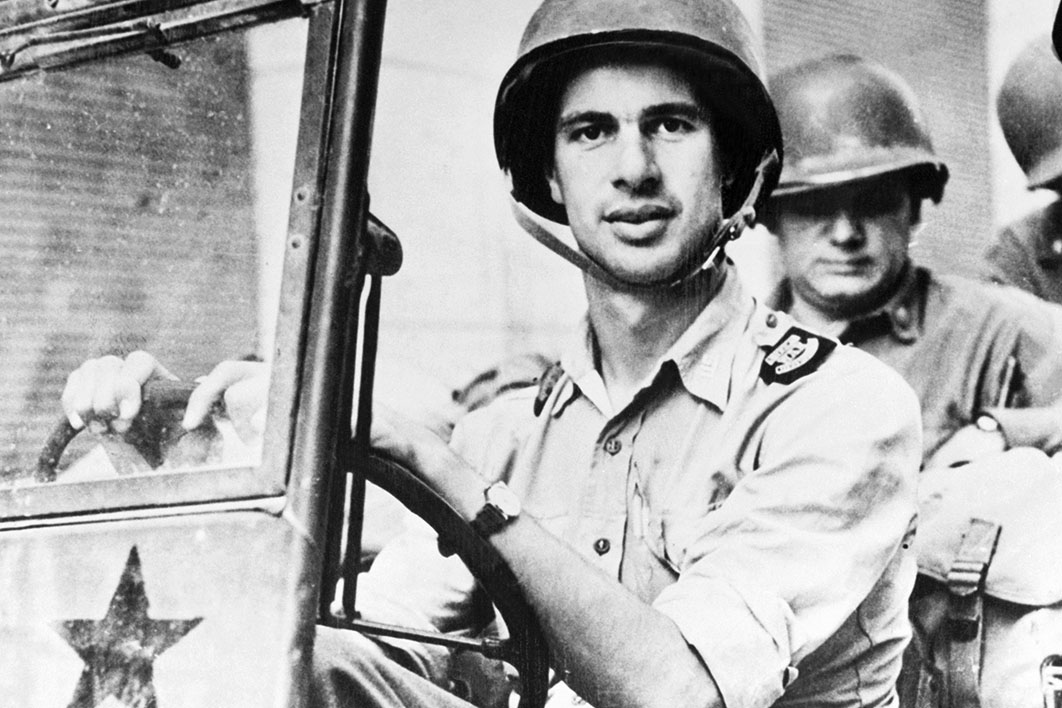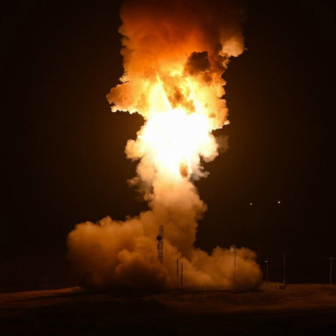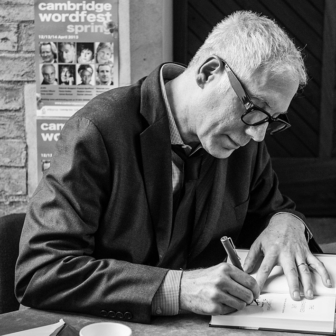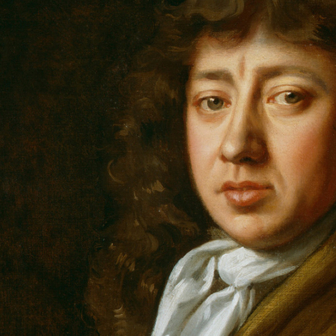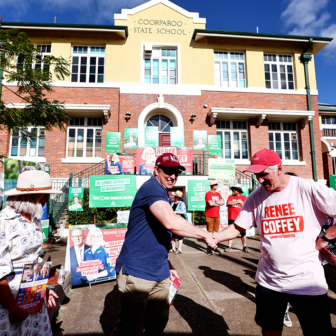A picture can be worth a thousand words, but not when it’s the one distributed by the American military after the first atomic bomb was dropped on 6 August 1945. As Lesley Blume writes in her new book, Fallout, the following day’s newspaper reports had to make do with government-supplied photos of General Leslie Groves, head of the Manhattan Project, studying a wall map of Japan.
It was three days later, when the second atomic bomb was dropped, that the now-familiar photo of the mushroom cloud rising nearly fourteen kilometres into the air above Nagasaki was released to the media. Taken by Lieutenant Charles Levy from an observation plane accompanying the bomber, it epitomised American military might.
But not the effects of that might. Photographer Yoshito Matsushige’s images of the destruction in Hiroshima were confiscated by the American military and only published once the peacetime occupation ended in 1952. Until then, few people outside the city had seen evidence of what happened to the people inside it.
Having used great resourcefulness to get into Hiroshima, Australian journalist Wilfred Burchett provided the first eyewitness account of what he called “the atomic plague” in the London Daily Express on 5 September 1945. Blume perhaps underplays Burchett’s worldwide scoop, but her focus in Fallout is to illuminate the importance of John Hersey’s article, simply titled “Hiroshima,” published a year later in the 31 August 1946 issue of the New Yorker.
At that time, and indeed right up to 1992, the New Yorker didn’t publish photographs. Hersey’s 31,000-word article occupied an entire issue of the magazine, a first in its twenty-six-year history. That is a lot of words, and Blume argues that they, more than photographs extolling military power or showing shattered buildings, have informed views about atomic bombs because they told the stories of six survivors from the moment of the bomb’s impact to several months afterward.
Since the publication of “Hiroshima” it has been hard for anyone to pretend that the impact of nuclear weapons, instantaneously and in lingering radiation sickness, is anything but horrific. Blume uses a quote from Hersey as her book’s epigraph: “What has kept the world safe from the bomb since 1945 has been the memory of what happened at Hiroshima.”
Here’s a paragraph from “Hiroshima” that, once read, is hard to forget. It concerns the efforts of one of the survivors, Reverend Kiyoshi Tanimoto, to save others:
Mr Tanimoto found about twenty men and women on the sandspit. He drove the boat onto the bank and urged them to get aboard. They did not move and he realized that they were too weak to lift themselves. He reached down and took a woman by the hands, but her skin slipped off in huge, glove-like pieces. He was so sickened by this that he had to sit down for a moment. Then he got out into the water and, though a small man, lifted several of the men and women, who were naked, into his boat. Their backs and breasts were clammy, and he remembered uneasily what the great burns he had seen during the day had been like: yellow at first, then red and swollen, with the skin sloughed off, and finally, in the evening, suppurated and smelly.
By now the tide has risen, making it harder for him to get across the water. Hersey continues:
On the other side, at a higher spit, he lifted the slimy living bodies out and carried them up the slope away from the tide. He had to keep consciously repeating to himself, “These are human beings.” It took him three trips to get them all across the river.
By bringing readers down from the aerial view of the city to people on the ground, Hersey opened space for them to imagine themselves in the shoes of a people whose military just a few years before had bombed Pearl Harbor, killing 2400 people and bringing the United States into the second world war.
Hersey’s decision to strip out any discussion of the debate about whether the two atomic bombings were necessary to win the war exposed him to criticism, particularly from Mary McCarthy (best known as author of the novel The Group), that he had reduced the uniqueness of the atomic bomb attack to the kind of “human interest” story that follows every natural disaster.
There is something to McCarthy’s criticism, but it’s not a big something. The fact that “Hiroshima” has little to say about the bomb’s necessity or otherwise flows from Hersey’s choice, encouraged and then patrolled in the drafting by New Yorker editor Harold Ross, to focus on “what happened not to buildings but to human beings,” as Hersey later put it. To portray the reality of their experience he needed to convey that perspective and that perspective only. It is this, though, that enables a mass audience to sympathise, even empathise, with the Japanese — something few had been able, or willing, to encourage.
No newspaper human-interest story has ever been as artfully composed as “Hiroshima,” either. Hersey drew on the structure of Thornton Wilder’s 1927 novel The Bridge of San Luis Rey, which he fortuitously came across while travelling to Japan. Wilder portrayed the interconnected lives of five people who were destined to die when a suspension bridge over a canyon in Peru broke with all of them on it.
Hersey uses a similar sequential narration device to tell the stories of six survivors of the Hiroshima bombing. The opening paragraph captures what each of the six was doing at the exact moment, 8.15am, when the bomb was dropped.
Toshiko Sasaki, a clerk, was “turning her head to speak to the girl at the next desk.” Dr Masakazu Fujii was “settling down cross-legged to read the Osaka Asahi on the porch of his private hospital.” Hatsuyo Nakamura “stood by the window of her kitchen, watching a neighbor tearing down his house.” Father Wilhelm Kleinsorge “reclined in his underwear on a cot on the top floor of his order’s three-story mission house.” Dr Terufumi Sasaki “walked along one of the hospital corridors with a blood specimen.” And the Reverend Kiyoshi Tanimoto “paused at the door of a rich man’s house in Koi, the city’s western suburb, and prepared to unload a handcart full of things he had evacuated from town in fear of the massive B-29 raid which everyone expected Hiroshima to suffer.”
In cutting from one person to the next, Hersey uses a cinematic effect completely familiar today but novel, in both senses of the word, in 1946.
His achievement was journalistic as well as literary. Blume lays out in detail just how much news “Hiroshima” contained. The number of deaths was 100,000, significantly higher than the US military’s official figure. Contrary to the official reason for choosing Hiroshima — that it was a military base — the overwhelming majority of the city’s population was civilian.
General Groves had consistently denied or downplayed the level of radiation sickness in the bombed cities, and told a Senate committee on atomic energy in late 1945 that doctors assured him radiation poisoning was “a very pleasant way to die.” But Hersey showed that levels of radiation poisoning were still alarmingly high in 1946 and that it wreaked terrible suffering on victims.
“Hiroshima” had an enormous impact. According to media historian Kathy Roberts Forde, all newsstand copies — priced at 15c — sold out within an hour. Within weeks, writes Blume, the magazine was selling for US$6 at secondhand bookshops. Albert Einstein, the Nobel prize–winning scientist and pacifist, requested 1000 reprints which he sent to leading scientists. The full article was read on the American Broadcasting Company radio network over four consecutive evenings.
As many as eighty newspapers and magazines around the world clamoured for rights to reprint the story, which Hersey granted with two conditions: that the proceeds go to the Red Cross and that the article run in full. It was published in book form in November 1946 and, according to Jeremy Treglown’s 2019 biography of Hersey, Mr Straight Arrow, sold more than 600,000 copies within a year.
Despite Hersey’s steering clear of the issue, or perhaps because of it, “Hiroshima” provoked the first full public debate about whether the United States was right to drop the bomb. “As I read, I had to constantly remind myself that we perpetrated this monstrous tragedy. We Americans,” one reader wrote in a letter to the New Yorker. An internal New Yorker report said Hersey’s article provoked a stronger response than any other in the magazine’s history, according to Forde. The great majority of the 400 letters were favourable, including a good number from readers who had noticed and praised Hersey’s “masterful storytelling.” A small number were critical: “Wonderful. Now write up the massacre of Nanking,” of Chinese people by Japanese soldiers in 1937, wrote one.
The response of commentators across the media was overwhelmingly positive. The New York Times editorialised:
The disasters at Hiroshima and Nagasaki were our handiwork. They were defended then, and are defended now, by the argument that they saved more lives than they took — more lives of Japanese as well as more lives of Americans. The argument may be sound or it may be unsound. One may think it sound when he recalls Tarawa, Iwo Jima, or Okinawa. One may think it unsound when he reads Mr Hersey.
What is remarkable about this editorial, writes Blume, is how at odds it is with the newspaper’s earlier, fervent support for the dropping of the atomic bomb. Not to mention the fact that one of its journalists, William Laurence, had been seconded in April 1945 from the newspaper to the Manhattan Project, where he wrote most of the press releases the media relied on in the days following the bombing.
After Burchett reported “the atomic plague” in September 1945, Laurence was among the journalists given a guided tour of the site of the original atomic bomb tests in New Mexico. His story, headlined “US Atom Bomb Site Belies Tokyo Tales,” reported that Geiger counters revealed “a minute quantity” of radiation in the ground, showing that Japanese claims of people dying from radiation sickness in Hiroshima and Nagasaki were a fiction.
When Hersey’s article was published, Laurence was about to release his own book, Dawn Over Zero, in which he extols the virtues of the nuclear power he had seen in July 1945, when the first bomb was exploded at New Mexico, and on board one of the planes in the bombing run for Nagasaki:
It was as if the earth had spoken and the suddenly iridescent clouds and sky had joined in one affirmative answer. Atomic energy — yes. It was like the grand finale of a mighty symphony of the elements, fascinating and terrifying, uplifting and crushing, ominous, devastating, full of great promise and great forebodings.
Blume lays bare the deeply entwined relationship between the most respected newspaper in the United States and the top-secret Manhattan Project. That relationship might have been covered by earlier writers such as Robert Jay Lifton and Greg Mitchell in Hiroshima in America: Fifty Years of Denial, but what hasn’t previously been covered — and what is one of the most extraordinary parts of this carefully researched, crisply written book — is the extent to which the New Yorker cooperated with the US military before publishing “Hiroshima” — for better and for worse.
Like the rest of the American media, the New Yorker sent stories to the War Department for clearance. The level of censorship of the magazine’s war coverage, though, had been light, according to Blume. The Office of Censorship closed down in late September 1945, but in early August the following year, just as Hersey and his editors at the New Yorker were feverishly editing “Hiroshima,” President Truman signed into law the Atomic Energy Act. The act restricted publication about “all data concerning the manufacture or utilization of atomic weapons.” Use of any such data that might harm the United States could “be punished by death or imprisonment for life.”
The magazine’s editor, Harold Ross, and his deputy, William Shawn, were worried this new restriction could kill their article. On advice from their lawyer, they felt they needed to get official clearance. They decided to send it not just to any government public relations officer but to General Groves himself.
Why? It isn’t clear. The records of the New Yorker, held at the New York Public Library, and General Groves’s papers have intriguing gaps, but Blume has pieced together the available information. She offers informed speculation about exactly what transpired in the negotiations between Groves and the magazine.
Blume points to speeches Groves had made defending the dropping of the atomic bomb. If anyone didn’t like the way the United States ended the war, his argument went, then they should “remember who started it.” She also shows that the United States’ own scientists had been to Hiroshima and discovered for themselves the extent of the damage and its lingering effects.
Groves had been the architect of the postwar information suppression campaign, but he was also concerned to protect the United States’ upper hand in the nuclear arms race, especially against the Soviet Union. Atomic bombs were now part of the world, he wrote in a memo in early 1946, and “We must have the best, the biggest and the most.”
Blume suggests that, perversely, the eyewitness accounts in “Hiroshima” could even have been “seen as an advertisement for the effectiveness of the weapon whose creation General Groves had spearheaded — and he had become increasingly concerned with receiving credit for his role in creating the war-winning weapon.” In other words, “Hiroshima” could be good PR for the general and the United States. Blume rightly describes this stance as “cynical,” and could also have described it as chillingly hypocritical.
After receiving the draft article, Groves called Shawn on 7 August 1946 and said he would approve the story. But he wanted to discuss “changing the article a little” in ways that “would not hurt the article” — words guaranteed to make any journalist’s blood run cold. But the negotiations were successful, and the article was run.
Blume shows what was lost, and what was left in or overlooked by General Groves. In the former category was a categorical statement by Hersey about Americans being wilfully kept in the dark about the exact height of the bomb’s detonation and the weight of uranium used. Gone was Hersey’s indignant line that “Trying to keep security on atomic fission is as fruitless as trying to keep a blanket of secrecy on the law of gravity.” Gone, too, was the fact that some parts of a comprehensive government report about the bomb’s effects were being kept secret.
What Groves let stand, though, was Hersey’s most disturbing revelation: in Blume’s words, that “the United States had unleashed destruction and suffering upon a largely civilian population on a scale unprecedented in human history and then tried to cover up the human cost of its new weapon.”
That the atomic bomb was not simply a more powerful bomb than any other but a qualitatively different kind of bomb was Hersey’s point — and Groves’s too. For Hersey, enabling people to see the bomb’s exact impact should prompt them to believe it should never be used again. For Groves, that should prompt readers to fear what their nation’s enemies might do and trust what their military leaders could, and would, do if necessary.
No atomic bomb has been dropped in a war since 1945. This might speak to the enduring power of “Hiroshima,” but nine countries have nuclear weapons, including North Korea and, of course, the United States, both of which have dangerously unstable and capricious leaders today. The Doomsday Clock, created by the Bulletin of the Atomic Scientists, is set at one hundred seconds to midnight, the closest since the nuclear watchdog was set up in 1947.
As Albert Einstein reflected in 1949, “I do not know how the Third World War will be fought, but I can tell you what they will use in the Fourth — rocks.” With that in mind as we commemorate the anniversary of the dropping of the first atomic bomb, read — or reread — “Hiroshima.” •
Fallout: The Hiroshima Cover-up and the Reporter Who Revealed It to the World
By Lesley Blume | Scribe | $35 | 288 pages
